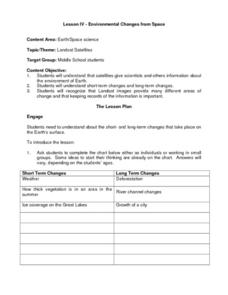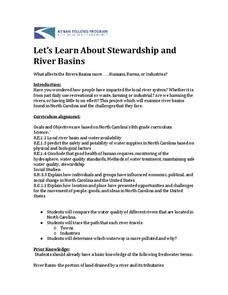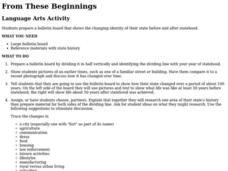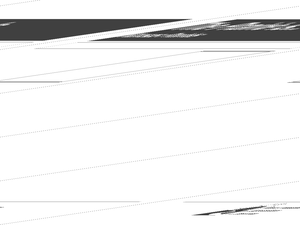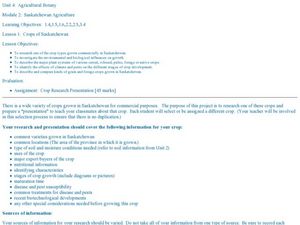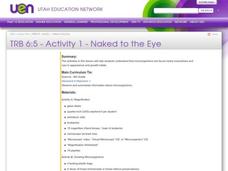Curated OER
Using Abiotic and Biotic Parameters to Monitor Air Quality
Students identify the abiotic factors that influence a river or stream and the organisms that live in it. They measure several abiotic and biotic parameters to gauge water quality. Students examine the biotic environment by identifying...
Curated OER
Where Do All the Toxins Go?
Students demonstrate how chemicals accumulate in fish fat. They study path ways of toxins in the fish's body and ways to prepare fish to avoid consuming the toxins. They examine U.S. and Canada regulations to protect the environment.
Curated OER
Soil, Designer Soil: From Rainforests to the Prairie
Students explore the role and importance of soil in the ecosystem. In this Science and Social Studies lesson plan, students complete an experiment using various kinds of soil and clay and then examine how soil has a direct impact...
Curated OER
Happy Endings: The Final Battle
Fifth graders explore all the myths of the battle of Yorktown. A variety of primary documents are viewed and analyzed for discussion. They become aware that what one sees and hears is not always as it seems in reality. Each group...
Curated OER
Park Brochures
Sixth graders investigate natural environments by researching national parks. In this brochure making lesson, 6th graders explore a specific national park and research it's information by utilizing the web. Students create travel...
Curated OER
In My Own Backyard
Students explore the soil and vegetation found in their home and/or school environment and map a familiar area. Each group is assigned a section of the schoolyard. They draw maps of their assigned places and gather soil and vegetation...
Curated OER
Agroforestry Challenge
Students explore agroforestry. In this Peace Corps lesson, students examine the role the trees play in deforestation efforts. Students then participate in an agroforestry game.
Curated OER
Environmental Changes from Space
Students discuss Landsat Satellites and the use of the images they provide as well as the purpose of keeping records of the information from the satellites. The class works in groups to complete a worksheet on short term and long term...
Kenan Fellows
Let's Learn About Stewardship and River Basins
What does it mean to be a good steward? Middle school environmentalists learn to care for their state's waterways through research, a guest speaker, and poster activity. Groups must locate and learn more about a river basin and the human...
Curated OER
From These Beginnings
Students prepare a bulletin board that shows the changing identity of their state before and after statehood.
Curated OER
Graze Like a Cow
Students explore how a cow digests the grass they eat. In this science/math lesson, students compare the quality of forage. Additionally, students determine the effects of rangeland health on the production.
Curated OER
Earth: The Food We Eat, The Seeds We Sow
Students explore the importance of seed diversity for cultural and ecological stability/health. They discover what an heirloom seed is and why they are important to conserve.
Curated OER
Is It Hog Wash, or Not?
Students investigate pathogens that can be present in pork products and summarize the responsibilities of pork farmers in ensuring the safety of their products. They also investigate the affects of hog farming on the environment and...
Curated OER
Hunters/Gatherers
Students discuss the ways in which an environment is used to provide the basic necessities of life. In groups, they compare and contrast how different hunter and gatherer groups have used the environment to their advantage. They place...
Curated OER
From the Flintstones to the Jetsons
Eighth graders compare and contrast transportation and agricultural methods in the United States from Colonization to Reconstruction. They, in groups, create and present Ohio Memory Scrapbooks to rest of class.
Curated OER
THE FARMER CARES FOR THE LAND
Students will identify cause and effect relationships in issues relating to Agriculture and the environment.Ask students to describe what farmers do. Then ask students to define the word "environmentalist." Ask students if they have...
Curated OER
Settling The Wasterwater Problem
Students name models that are representations of larger objects. They suggest ways that industry, agriculture, and mining affect water quality. Pupils demonstrate the use of lagoons for treating wastewater. Students define the...
Curated OER
The Prairie Is...
Students investigate different environments by creating a poem. For this prairie environment lesson, students research information about Kansas' natural resources and complete a worksheet about prairies. Students practice using...
Curated OER
What is Drought?
Students explore and conduct an experiment on the effects of drought on the environment. They define what drought is and the impact that a shortage of rainfall can have on agriculture, municipal water supplies, tourism, recreation, etc.
Curated OER
Crops of Saskatchewan
Students research one of the commercial crops grown in Saskatchewan. In this agriculture lesson, students discover locations, characteristics, common problems, and biotechnological developments related to the crops of Saskatchewan.
Curated OER
Sustainable Dining
Students evaluate the how their product choices impact the environment. They discuss the concept of sustainability in agriculture. Students give reasons for buying sustainable food products. A cost-benefit analysis concerning sustainable...
Curated OER
Seeds, Miraculous Seeds
Students investigate the growth of seeds. In this agricultural lesson, students dissect a bean and corn seed and identify the parts of the seed. Students observe the development of a pinto bean seed and record observations on the...
Curated OER
Vermicomposting
Fifth graders explore agriculture by viewing compost related presentations. In this worm and soil lesson, 5th graders identify the relationship between good soil and the worms who inhabit it by reading assigned text in class. Students...
Curated OER
Naked to the Eye
Sixth graders conduct a variety of experiments that enable them to investigate bacteria. They use microscopes, prepared slides, video, moldy bread and pond water to observe types of bacteria and how bacteria interacts with the...







